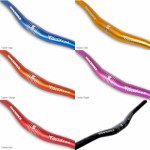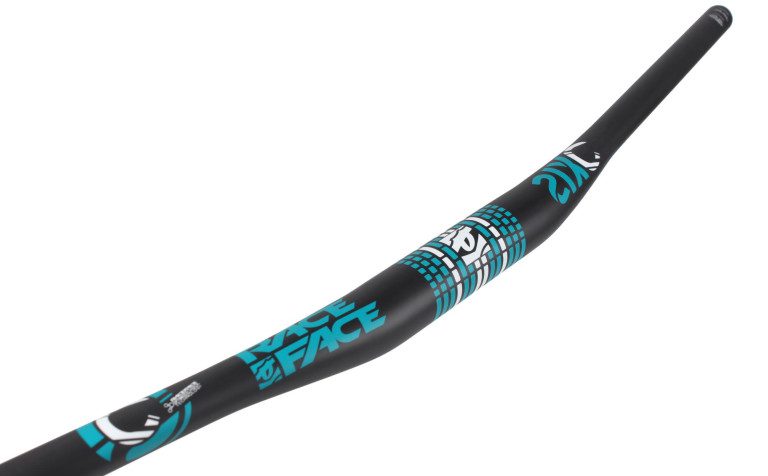They aren’t just straight pipes. Selecting the most suitable handlebar for your bike and your riding is important. It’s thankfully nicely straightforward. Here’s the low-down.
Your hands govern how your bike rides. Where you put them and how they interact wit the bike and the trail is dictated by your handlebar. It’s an important component that has a massive effect on your whole riding experience.
Mountain bike handlebars have four main variables: width, rise, sweep, and material.

Width
Mountain bike handlebars have got wider over the past decade or so. The common range for a normal bar width has now settled down to between 700mm to 800mm (27.5″ to 31.5″ in old money).
What width you choose to ride is a matter of personal preference, terrain and body shape. We would recommend buying a bar that appears to be too wide – you can always easily trim it down to a finalised, desired size after a couple of test rides. If you’re finding it too hard to pull the front wheel up then the bars may need a trim. Otherwise leave it nice and wide.
Very few people regret making the move to a wider handlebar. With a proper width handlebar you’ll no longer be riding with the outside of your palms hanging off the ends of the grips. This results in more comfort and a surprising amount more control.
A wide bar in general improves your bike handling, control and confidence. Greater balance and stability. Your cornering ability will also improve.
Rise
How much upwards rise a handlebar has. Not applicable to flat bars which are… er, flat. Bars with low-to-mid rises are the norm (20mm to 35mm). You can get low rise bars (7mm-20mm rise) and high rise bars (35mm- 50mm rise).
50mm rise).
Again, it’s a personal preference and body shape thing as to which sort of rise you get along with best. Having said that, as wheel sizes have got bigger and suspension has got longer, the trend for lower rise bars has developed. If in doubt, just go for mid-rise.
The range of long travel 29ers now available has lead to a rebirth of the flat bar. Once the reserve of lycra XC racers, the nu skool flat bars are much, much wider (700mm to 800mm just like modern riser bars).
Sweep
 Sweep dictates the bar’s shape. Sweep refers to how swept-back and swept-up the handlebar is. Handlebars are not straight, even flat bars are swept in some way.
Sweep dictates the bar’s shape. Sweep refers to how swept-back and swept-up the handlebar is. Handlebars are not straight, even flat bars are swept in some way.
Handlebars are swept in two dimension: back and up. The common range of back sweep is anywhere between 6° and 9°. The common range of up sweep is 4° to 5°.
It’s this combination of sweeps that give a handlebar its handling characteristics. A good mid-range combo is 8° back and 4° up. Most people suit this bar shape.
Material
Handlebars are either aluminium or carbon. Carbon is usually the more expensive option and can be lighter and stiffer. Manufacturers of carbon bars also claim that it can reduce tiny vibrations – ‘buzz’ – but we’re not sure how effective or relevant this is for mountain biking.
The vast majority of handlebars are made from aluminium. A high end aluminium handlebar is a small work of engineering art that undergoes several high tech manufacturing processes. They aren’t just pipes. Check out the video above for a bit of Easton’s bar testing rig.

Other things to bear in mind
Pretty much all modern mountain bikes come with stems that take 31.8mm diameter handlebars. There are two other clamp sizes out there: the olden days 25.4mm standard and the 35mm standard. The 35mm standard is super, super stiff and aimed at Downhill or top-end Enduro racers.
You need to get the correct diameter bar for your intended stem regardless.
Markings
Decent handlebars have two sets of markings on them. One set is in the middle of the handlebar and helps you position the bar centrally in the stem clamp. Some bars also have these markings numbered/marked in increments; to help you accurately and consistently position your bars exactly how you like them.
The other markings you encounter are cut-down or trim markings. These are lines towards the ends of the handlebar that enable you to cut down your bars evenly and accurately at each end.

Which handlebar should you buy?
Cross country riders and racers are finally ditching their narrow bars and realising that a few paltry grams is a price worth paying for increased endurance comfort and rapid descending handling that comes with wider bars. Carbon low-rise or flat bars between 720mm to 740mm are a great choice.
Trail riders can safely embrace the wide, mid-rise bar and enjoy a whole new world of comfort and joy. Carbon if you can afford it. Aluminium is more than fine if not. Get some 780mm wide, 25mm rise bars and see how they ride. Trim them down after a couple of rides if you need to.
Downhillers should take this opportunity to embrace the new 35mm diameter standard. Hugely stiff with minimal – if any – weight penalty. There are even 35mm diameter, 800mm wide flat bars available these days.

very nice article. a perfect guide.